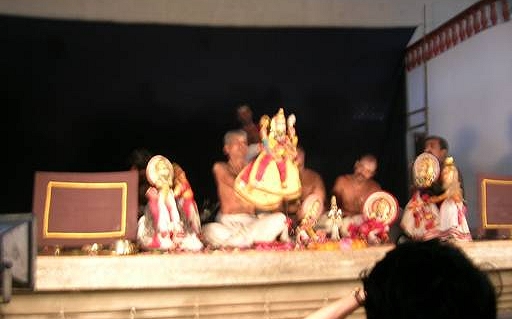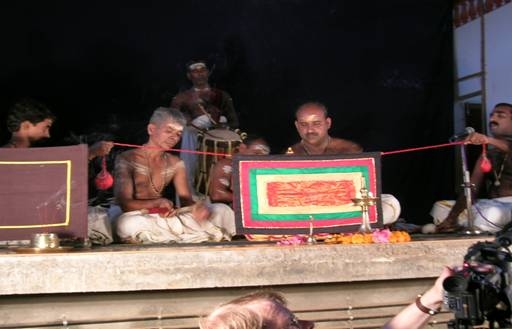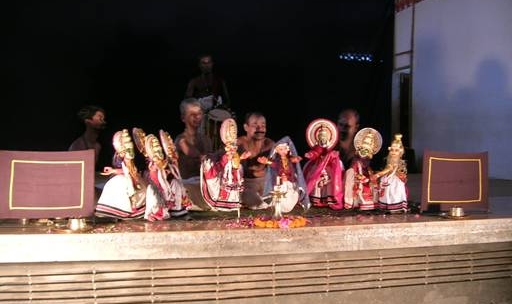
|
 |

|
 |
Dancing Dolls: Pava Kathakali - Padma Jayaraj, Thrissur e-mail: padmajayaraj@sancharnet.in April 7, 2006 Puppetry is ancient theatre, as old as civilisation itself. In India, it existed since 200 BC in the state of Maharashtra. Gradually it spread to Central and Southern India. It branched off into glove puppetry, string puppetry, and shadow theatre. Puppetry incorporated epic themes, legends and stories that sprang from life's experience. Glove puppetry thrived with its simplicity in rural parts carried on by nomadic tribes. They sang of local legends and lore. In Kerala, the puppeteers were called andipandarams who spoke a mixture of Telugu and Malayalam, a pointer to their original home. These wandering puppeteers that coloured the imagination of folk, is a vanished breed to day. In 18th century, under the influence of Kathakali, glove puppeteers began to dress their puppets in Kathakali costumes; they adapted themes from Attakatha, the text of Kathakali.  Puppets The heights of the puppets vary from 1 foot to 2 feet. They are carved delicately in wood, painted, gilded, and decorated by transparent coral, peacock feathers and such adornments. Under its wooden upper portion of the body is a bag concealed by a flowing robe. The puppeteer inserts his hand into the bag and manipulates the puppet with his fingers. Its hands are operated with the thumb and middle finger while the head is controlled by the index finger. In the past the troupe performed, accompanied by a traditional musical ensemble, in houses that gave them the needed cultural ambience. Sivarathri and Thiruvathira that demanded keeping awake as religious observance, presented occasions for performances. The episodes were from the Mahabharatha. And the artistes were quite well known once upon a time. But soon it disappeared from its social base in Kerala. Revival In 1981 the revival occurred thanks to the efforts of Sangeet Natak Akademi and the Department of Culture, Govt of India. They unearthed old puppets and made new ones; trained artistes; composed plays. From 1984 to 87 the dolls performed in various international forums representing India. The artists are frequently invited by educational institutions and research centres abroad. Sadly, Pava Kathakali remains unknown in its home. Pava Kathakali is a valuable introduction to Kathakali. The stories enacted are Kalyana Sougandhikam, Duryodhana Vadham from the Mahabharatha, Ravanotthbhavam and Thoranayudham from the Ramayana, Daksha Yagam from Siva Puranam. You can understand the typical characters: pacha, kathi, thadi, minukku etc made distinctive by costumes that are exclusive to Kathakali. The distinctive stamp of Pava Kathakali compared to other forms of puppetry in other parts of India, is its classical dimension. A performance begins on a ritualistically sanctified stage, with a lighted lamp and a measure of paddy in front. Then the show starts, with the traditional musical ensemble of five instruments as in Kathakali. Soon, a miniature screen reveals the headgear of the prominent character of the piece. The drama begins with the singer narrating the story. You watch everything except the mudras, the highly stylised gestures. Three to four artists perform on the stage at a time for a maximum of one hour. There is a need to introduce children into our traditional arts.  Maya Tangeberg, a visiting theatre person from Finland, arranged a program for school kids in Thrissur. The story of Kalyana Sougandhikam is in the air in Kerala. But the kids enjoyed the way the dolls danced as the performers involuntarily depicted the drama of human emotions on their face. The love and affection that Hanuman bears for his younger brother Bhim, the way in which he tests and moulds the youngster's character are lessons in values that children imbibe unconsciously. And the story is sung with a lot of humour that enlivens a live performance. The second item was Duryodhana Vadham. Unlike Kathakali, the story takes you to its very roots: Draupathi Vasthrashepam. In spite of its antiquity, the entire idea has become a metaphor today. Man cannot trespass certain limits, the old guards cannot abdicate their responsibility, women have dignity, and for every action there is a reaction, are some ideas that the story churns out.  Sreenivasan, the leader of the troupe, said that they were invited by households to perform, as a treat on children's birthdays while touring Germany. This art form is developed and protected by G Venu, Natana Kairali, Irinjalakkuda. You can book a show. There are orders for dolls too from abroad. On the international scene, Pava Kathakali occupies an important position along with Chinese puppetry. Padma Jayaraj is a regular contributor to narthaki.com |